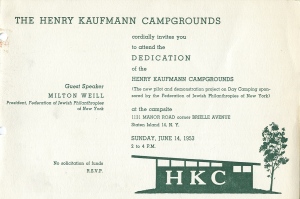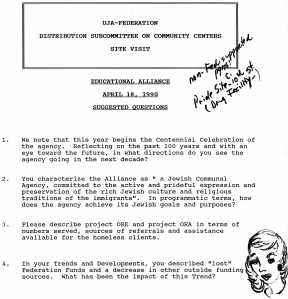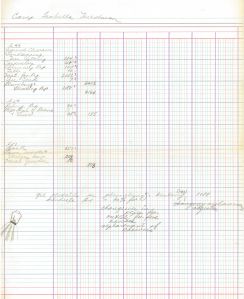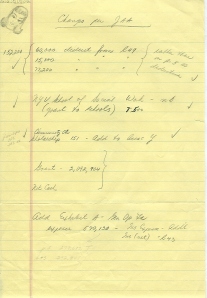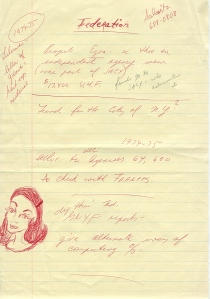One of the major issues that UJA-Federation is faced with to this day is Jewish poverty. Jewish poverty has been a concern to Federation of Jewish Philanthropies (FJP) and UJA-Federation (UJF) throughout its long history. One agency in particular that FJP funded and UJA-Federation continues to fund that deals primarily with the issue of Jewish poverty is the Metropolitan New York Coordinating Council on Jewish Poverty (later the Metropolitan Council on Jewish Poverty). The files of this agency can be found in the annual agency budget files of FJP as well as UJF, starting in the 1978-1979 fiscal year as a subvention and later becoming a part of the Community Relations/Development files in the 1980s. The files continue through the 1990s. Files pertaining to Jewish poverty can also be found in the Budget Department Subject Files, in the Sanford Solender-William Kahn Subject Files, and in the Stephen Solender Subject Files.
In 1972, it was estimated that the number of impoverished Jews stood at approximately 300,000 people, most likely as a result of the 1971 Jewish population survey. This statistic helped prompt the establishment of the Metropolitan Council in 1972 and its mission was “to combat poverty in Jewish neighborhoods through community-based offices on a city-wide basis.” The agency’s mission was carried out in a two-fold manner. First, social services agencies provided information and referral and crisis oriented services and second through community development programs which served to combat crime, improve housing and generate community policy in targeted areas.
In the UJF subgroup, during the 1990-1991 fiscal year, the Metropolitan Council provided services for the elderly, homeless and Jewish poor of New York in conjunction with 21 UJF-funded locally based Jewish Community Councils. The Jewish Community Councils assisted the poor in their communities in obtaining essential services from government and private agencies such as Medicare, Medicaid, Public Assistance, SSI, Food Stamps, housing, employment, legal services, transportation and escort services, clothing and furniture. The Met Council administered these programs in conjunction with the New York City Departments for the Aging, Human Resources Administration and the Community Development Agency, as well as UJA-Federation.
The Met Council also provided various neighborhood preservation services. Crime prevention, housing issues and community policy were addressed in coalition groups with local synagogues, government offices and civic groups. Funding for neighborhood preservation efforts came from the Department of Housing Preservation and Development of New York City and the State Department of Housing and Community Renewal.
Currently, Met Council works in conjunction with 25 locally based JCCs. The release of UJA-Federation of New York’s 2011 population study published in consultation with Met Council, “The Jewish Community Study”, is published on the Met Council website (accessible here). On their website, it is stated that currently “the Met Council serves over 100,000 clients on site and throughout our network of Jewish Community Councils in each of the City’s five boroughs. From affordable housing, capacity building initiatives, career services, crisis intervention, and family violence services, to health insurance enrollment assistance, home care programs, home services, immigrant services, and kosher food distribution, Met Council continues to be the voice of New York’s poor and working poor.”
In the UJA-Federation of New York’s 2011 Executive Summary of this survey (http://www.ujafedny.org/get/196901/download), it was mentioned that today “nearly 1 in 5 Jewish households is poor today, with incomes under 150% of the federal poverty guideline, and the proportion of poor Jewish households is higher than it was 10 years ago. The relative increase has been especially dramatic in the suburbs, where 10 years ago there was very little Jewish poverty. In the eight-county area, 130,000 Jewish households are poor. In terms of individuals, 361,000 people (both Jews and non-Jews) live in poor Jewish households. About 19% of all Jewish households are poor, as are 20% of all people in Jewish households — a considerable increase since 2002, when 15% of people in Jewish households in the New York area lived in poverty. Jewish poverty has increased considerably in the suburbs, but it is still greatest in New York City, where 24% of Jewish households and 27% of all people in Jewish households are poor (compared with 20% of all people in New York City Jewish households living in poverty in 2002). An additional 1 in 10 Jewish households is “near poor” — households with incomes between 150% and 250% of the federal poverty guideline. Beyond the people living in poor Jewish households, an additional 204,000 people can be classified as near poor. Thus, 565,000 people living in Jewish households in New York are affected by poverty.”
In an email newsletter (“The Reality of Jewish Poverty in New York”) dispensed by John Ruskay, CEO of UJA-Federation of New York, nearly two weeks ago and accessible here, he mentioned that Jewish poverty is a painful reality in the New York community. He cited the above statistics and talked about the magnitude of the numbers and why it is so difficult to comprehend. In order to highlight the magnitude of poverty, Ruskay provided several examples such as the Masbia restaurant-style soup kitchens in Brooklyn and Queens run by the Met Council on Jewish Poverty and Project ORE operated by the Educational Alliance in Lower Manhattan. He went on to mention how hundreds of people wait for hours on line for a package of groceries provided by the Met Council. Finally, he stated that we must be a caring community and that no agency or philanthropy will eradicate Jewish poverty, but only through our eyes and hearts that we can make things better.
